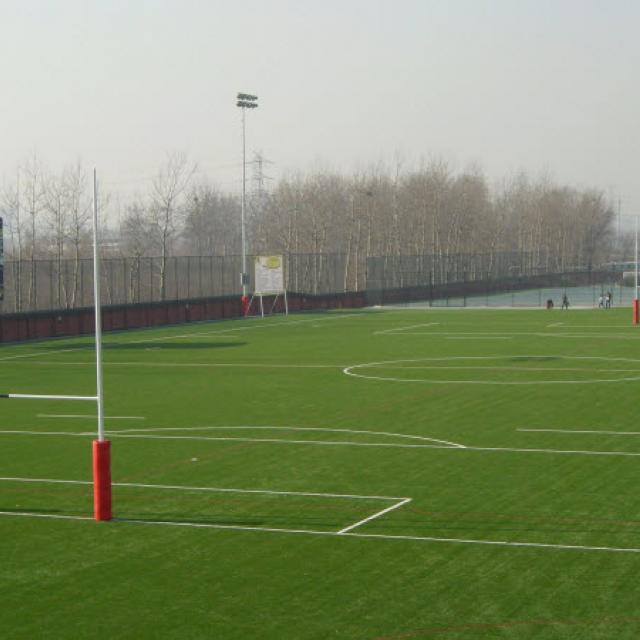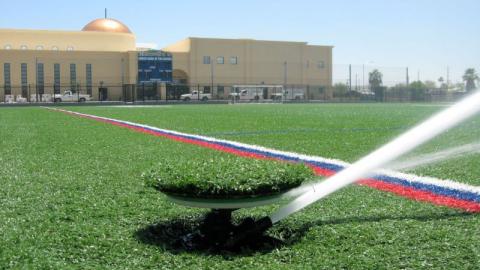First, let’s be clear that if given a choice, most everyone would prefer a natural turf sports field. However, many school and recreational sports fields today must support nearly constant use. This extensive activity creates the need for considerable maintenance in order to keep the surface playable and safe. Unfortunately, these facilities rarely have the resources or budget to accomplish this task, so the fields begin to degenerate and become unsafe. When faced with the choice of a potentially dangerous natural turf playing surface or a safe and durable synthetic surface, the choice is often very clear.

The challenge then becomes how to pay for the new surface. This funding is often generated via fundraising and donation type activities. Let the buyer beware. Don’t be fooled into thinking that the new synthetic field will require zero maintenance and zero water. Of course there are maintenance cost advantages of synthetic turf relative to natural turf. However, modern-day third-generation synthetic surfaces do need regular maintenance with specialized equipment and water in order for them to reach their intended life expectancy.
To clean, to cool, or to improve playability?
For many, the primary reason for irrigating synthetic turf is to provide cleaning capabilities. The need for cleaning exists almost immediately, as construction activities on and around the field creates considerable amounts of dust and dirt. Of course, in many parts of the world, dust storms are abundant so regular irrigation is needed to flush and clean the fields. High-intensity sports participants perspire, receive skin abrasions, and occasionally fall ill, causing the need to clean the field. There is also growing concern about the infill material breaking down, which creates dust that players ingest as they slide and fall on the turf. Regular irrigation will clean the field and flush these dust particles through to the bottom of the turf. Some fields must also support several different sports throughout the year. This is particularly true in the States where a high school field must support American football, soccer, lacrosse and field hockey. To minimize player and spectator confusion, the primary one or two sports will have the field lined using the coloured synthetic turf fibres of the field. The ancillary sports will have the lines added for their season using water-soluble paint. After the season ends, the paint is then removed with water and flushed through with the irrigation system.
Rich Dunn, Hunter Industries : " I came to realize there is a strong worldwide trend toward including irrigation on synthetic sports fields, yet there are many differing reasons and various perspectives as to how it should be accomplished".
For others, heat reduction is the primary reason for irrigating a synthetic turf sports field. While current third-generation synthetic fields have many advantages over their predecessors, they can generate high heat when exposed to direct sunlight. A sunny, cloud-free day with ambient temperatures of 35 C can produce temperatures of 70 C on the field. Irrigating these fields can dramatically reduce the temperature within a matter of minutes. Unfortunately, this heat reduction is short lived as the temperature will slowly begin to rise after the irrigation cycle. The higher the ambient temperature, the faster the field temperature will rise. For this reason, many field managers at high-use facilities will irrigate not only between games but also during the halftime period. Some have expressed concern that irrigation will increase the humidity on the field. This is true and there is no disputing that high heat coupled with high humidity can be an uncomfortable and concerning combination. The application of water will reduce the field temperature but increase the humidity. As the surface temperature starts to rise again, the humidity will decrease. This cycle will continue as additional water is applied. Many managers believe that the trade off in brief humidity is worth preventing possible injuries that can result from unsafe surface temperatures.
Finally, for some, the primary use for irrigation on synthetic fields is to improve the playability of the surface. I have been told that many professional football (soccer) players prefer an irrigated synthetic field because the action of the ball and the feel of the surface is much more like a natural turf field when compared to a non-irrigated synthetic field. And of course for field hockey, water is required to create the desired playing surface and ball action.
In the air, in the turf or in a vault?
The quantity and configuration of the sprinklers used for synthetic turf irrigation vary around the world as well. All sprinklers are long-range products installed around the perimeter of the field, as sprinklers are not allowed within the field of play. Generally speaking, the majority of fields are designed with either six sprinklers (three along each sideline) or eight sprinklers (four along each sideline). There are certainly exceptions with some designs that include a designer’s preference to have a sprinkler behind the goal at each end of the field. The six-sprinkler configurations use fewer sprinklers but require the use of the largest nozzles flowing 1000 to 1250 litres per minute. These nozzles also require high pressure of up to 8 bar in order to work effectively. I’ve seen a growing trend where designers are using the eight-sprinkler configuration but using smaller, lower flow nozzles that can be run effectively at lower pressures. Many are more comfortable with these lower pressure 6-bar systems.
In the past, many synthetic turf irrigation systems included sprinklers that were installed in the open air above ground. These were either at ground level, on top of a 3-metre riser pipe, or sometimes on a riser pipe eight metres or more above the surface. The intent when using these very tall risers was to place the sprinkler above the view of the spectators. While obstructing the spectator’s view is a concern with these above ground installations, there are newer, more compact gear-driven sprinklers available today to help minimize this issue. These above ground systems are sometimes the most logical choice when retrofitting irrigation on an existing synthetic turf field.
"As an alternative to the above ground systems, most modern-day installations are being installed sub-surface".
As an alternative to the above ground systems, most modern-day installations are being installed sub-surface. This creates a much cleaner and more aesthetically desirable installation when pop-up sprinklers are part of the design. However, this aesthetic appeal comes with its challenges. Properly-designed and installed synthetic sports fields include a surface that is constructed to a near-perfect elevation to grade. There is also a finely orchestrated gradient of compacted field base material, a drainage system, a padding system below the turf “carpet”, turf that is stitched and/or glued together with adhesives, and finally a field topping with the infill material integrated within the turf’s fibres. In the final analysis, it is highly desirable to eliminate any need to cut into this surface to conduct sprinkler repairs, as it is nearly impossible to restore the surface to its original perfection. For this reason, I have seen a strong move away from directly burying sprinklers in the synthetic surface. Instead, sub-surface vault systems are being used in order to provide irrigation system access without ever having to disturb the integrity of the synthetic surface.
In the golf industry, this beneficial concept is called TTS or Total Top Serviceability. Not unlike a golf TTS system, the TTS synthetic turf irrigation system is designed to provide access to all of the irrigation components from the surface without cutting into the turf. These include the sprinkler, the control valve, the manifold, the isolation valve, the drain valve, the quick coupler valve and even the point of connection to the sub-mainline. At the same time, it is imperative that these vault-type systems provide a smooth and safe transition from the surrounding surface to the vault’s surface and through to the retracted pop-up sprinkler’s surface. This presents its own set of challenges as there are four types of vault installations that must be accommodated: infill turf over vault (football), short turf over vault (hockey), synthetic running track over vault, and concrete surrounding vault. Fortunately, the industry has evolved to the point where these challenges are easily overcome with the many solutions that are available today.
One thing is clear, applying water to synthetic turf sports fields is popular worldwide, and the practice is growing. Whether a synthetic sports turf irrigation system is needed for cleaning, cooling, playability, or a combination of all three, the irrigation industry is responding with innovative products to meet your needs for a variety of playing surfaces and installations.

